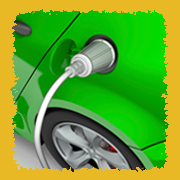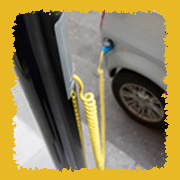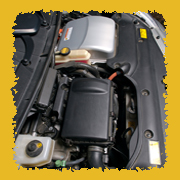Tell Me More Electrical Safety-SMART! Home
Electric Vehicles
Electric vehicles (EVs) run on electrical energy instead of—or in addition to—gasoline. Industry experts anticipate there will be over a million EVs on the roads this decade. They are popular for many reasons:
- EVs help reduce pollution.
- EVs cost less to run than gasoline vehicles.
- EVs reduce our dependency on gasoline.
Battery Electric Vehicles
Battery EVs run entirely on electrical energy. Instead of a fuel tank, batteries store the electricity that is used to operate an EV. These batteries can be charged by plugging the vehicle into a charging station or a 220 V outlet at a home or an office. The batteries store the electricity until the vehicle is driven.
Examples of battery EVs include golf carts, scooters, and other personal vehicles used for short trips at low speeds. Some automakers have recently introduced very compact, two-passenger EVs for use in urban areas. These cars have a top speed of 25 mph and can travel a little over 50 miles per charge—perfect for short trips in the stop-and-go traffic of a large city.
Under the hood, an EV consists of an electric motor, one or more controllers, and batteries. The controller governs the amount of electricity that flows from the batteries to the motor when the driver steps on the accelerator. The motor changes electrical energy from the batteries to mechanical energy, which makes the vehicle move.
Driving an EV down the road produces no pollution at all. Even when pollution related to power plant electricity production is factored in, EVs produce less pollution than gasoline or diesel vehicles. EVs are also twice as efficient as gasoline or diesel vehicles, if you compare the energy used in creating gasoline at a refinery to producing electricity in a power plant.
When an EV is stopped in traffic, it doesn't have to use fuel to keep the motor running like a gasoline engine does. Added efficiency is created by something called "regenerative braking." When an EV slows down, the motor continues to turn, but the power no longer flows to the wheels. Instead, the power is fed back to the batteries, giving them a small charge every time the driver stops or goes downhill.
Hybrid Electric Vehicles
A hybrid vehicle is any vehicle that uses two or more power sources. The most common hybrids on the road today are gasoline-electric hybrids, also called hybrid EVs. A gasoline engine and an electric motor power these vehicles. The popularity of hybrid EVs is on the increase, and automakers are busy designing and building new models.
The major components of a hybrid EV include a gasoline engine, an electric motor, a transmission, and, in some models, a generator. A fuel tank stores gasoline for the engine, and a battery pack stores electricity for the motor. The transmission moves, or transmits, mechanical energy from the engine or motor to the vehicle's wheels.
Hybrid EVs use smaller, more efficient gasoline engines than conventional gasoline or diesel vehicles. Hybrid EVs also produce less tailpipe emissions and provide much better gas mileage. Burning less fuel means producing fewer pollutants. Hybrid EVs also release less carbon dioxide into the air. Carbon dioxide is a greenhouse gas that contributes to global warming.
Current hybrid EV models are similar in size and comfort level to the most popular gasoline-powered automobiles. Unlike battery EVs, hybrids don't have to be plugged in. Their batteries are charged by the gasoline engine and by the electric motor or generator during normal operation. Regenerative braking charges the batteries slightly when the car slows down, recovering some of the energy that's usually lost when brakes are applied.








